The role of wildlife rehabilitation and breeding centres in species reintroduction programmes
Outdoor adaptation aviary located in the “Sinite Kamani” Nature Park, Bulgaria, with vultures translocated from Spain
Every year, the Alfred Toepfer Natural Heritage Scholarship supports the work of young conservationists in Protected Areas across Europe. Réka Szilágyi, was one of the winners of the Scholarship in 2020 and travelled to Bulgaria and Spain to learn more about the role of wildlife rehabilitation and breeding centres in vulture reintroduction programmes. The following article is written by Réka . The current call for scholarships is also opened
Reka works as IT professional at Milvus Group Bird and Nature Protection Association (Targu Mures, Romania) and provides assistance at the Milvus Group’s Wildlife Rehabilitation Center.
Global biodiversity is facing an unprecedented crisis, mainly due to the accelerating loss of natural habitats, biological invasions and global climate change. One of the active conservation measures which can be applied to mitigate biodiversity loss is the international translocation of endangered species through reinforcement and reintroduction programmes. These initiatives aim to artificially increase an existing but declining population (reinforcement) or to re-establish an extinct population (reintroduction). Both are carried out by the translocation of wild or captive-bred individuals inside their natural distribution range. These measures require the joint effort of several institutions and organizations, such as wildlife rehabilitation centres, National Parks and local authorities.
Watch Réka’s video summary!
With the support of the Alfred Toepfer Natural Heritage Scholarship I studied the role of wildlife rehabilitation and breeding centres in the reinforcement and reintroduction of four endangered European vulture species. I especially focussed on the collaboration between the rehabilitation and breeding centres and the entities responsible for the management of Protected Areas where these vulture populations live. On my study tour I visited three wildlife rehabilitation and breeding centres, one in Bulgaria and two in Spain: the Green Balkans Wildlife Rehabilitation and Breeding Center (Bulgaria), the AMUS Wild Fauna Hospital and the GREFA Wildlife Hospital and Breeding Center (Spain). I also visited the “Sinite Kamani” Nature Park in Bulgaria, and the Sierra Grande de Hornachos SPA and the Valle de Iruelas Nature Reserve in Spain.
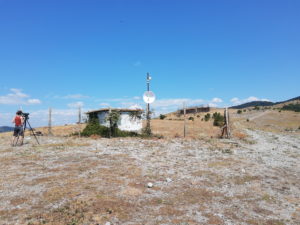
Réka during her study trip
The three wildlife rehabilitation and breeding centres have a wide range of activities. Besides participating in different reintroduction programmes by captive breeding of endangered species, they shelter illegally traded and confiscated animals and provide veterinary care and rehabilitation to wild individuals. Some of the centres are also open to the public and therefore have an important role in environmental education. They are visited annually by thousands of children and adults, who can gain valuable knowledge about the species of the local fauna, and can learn about the human impact on wildlife and the challenges faced by wildlife conservation.
The visited wildlife rehabilitation and breeding centres are actively involved in vulture reinforcement and reintroduction programmes as well. The processes of reinforcement and reintroduction involve several techniques to increase/re-establish the target population. One of the methods is the captive breeding of individuals and their release into the wild. The most successful method to release captive bred individuals is called “hacking”. During hacking, chicks are placed in artificial nests, located in their release site, and are fed with minimal human contact until they become independent. Another method for reintroduction is the translocation of wild subadult or adult individuals from a source population. In this latter case the translocated birds are usually specimen found in distress in the wild, and which have been treated in the rehabilitation and breeding centres. Following their full recovery, the individuals are transported to the target country. Once arrived at the translocation site, birds spend several months in specially designed outdoor adaptation aviaries until they become familiar with their new environment, after which they finally get released into the wild.
The entities managing the Protected Areas where rehabilitated birds are being released have an important role in the success of reinforcement/reintroduction programmes.
A strong collaboration between the rehabilitation and breeding centres and Protected Area management is essential.
The involvement of the Protected Areas management can improve the visibility of the programmes by reaching the visitors directly, on site, through information panels, leaflets, mobile applications, or educational activities. Protected Area management might also have a more active collaboration with the local communities, thus they can play an important role in the propagation of the programme among the local stakeholders, ultimately improving the social acceptance of the initiative. The rangers or the field specialists frequently collaborating with the area’s management, have a wide knowledge about the fine-scale characteristics of the area. Hence, their experience could help in the evaluation and elimination of potential threats which reintroduced individuals face after their release, such as electrocution, poaching or poisoning.
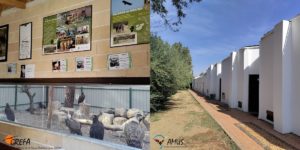
Vultures in the visitor area of the GREFA Wildlife Hospital and Breeding Center (left) and the Rehabilitation area at the AMUS Wild Fauna Hospital (right)
During my study tour I gained valuable knowledge on the role of wildlife rehabilitation and breeding centres and Protected Areas’ management in reinforcement/reintroduction programmes. The best practices I learnt about can provide guidance for designing and implementing vulture reintroduction programmes in Romania. The gathered information can be useful also for international specialists interested in wildlife rehabilitation or vulture reintroduction, and for entities managing Protected Areas, in order to increase and diversify their efforts invested in similar initiatives.
Do you want to get to know Réka better? She will present her work at the EUROPARC Conference in Austria. Last year, we’ve also asked her some questions about her study trip in our EUROPARC Podcast:
Application to the Alfred Toepfer Scholarship 2022 are currently opened. Apply until the 29th of April!
Introducing Prof. Noelle Aarts!
The EUROPARC Conference in Austria will take participants through the wide world of communications. Our expert keynote speakers will be our guides. Today, get to know Prof. Noelle Aarts.
Noelle Aarts is a professor of Socio-Ecological Interactions and director of the Institute for Science in Society (ISiS) at the Radboud University in Nijmegen. Her research focuses on interactional processes for creating space for change towards socio-ecological transformations, developing insights into the interplay between everyday conversations and wider structures and developments in society. In other words:
If you want to change how people think, start by changing the way they talk (Bate, 2004: 37).
This is one of Noelle’s favourite quotes. Understandable: as a professor of socio-ecological interactions, she studies communication in multi-stakeholder processes on complex societal challenges such as climate change, biodiversity loss and human-animal relationships in the context of crossing boundaries. With her research she tries to contribute to a sustainable and healthy society.
During her Keynote Address “The Art of Dialogue – Understanding conversations for Sustainable Change”, Noelle will speak about multi-stakeholder collaboration processes. In these situations, multiple conversations are taking place at the same time, however, they are not always effective! Instead of building fruitful relations, these conversations often result in an even bigger distance between opponents. In her presentation, she will explain why these conversations are so difficult and how we can improve these processes.
Noelle will join us through a livestream for an interactive address. Want to get a taste of what’s in store? Check out this video:
Early bird prices are still running until the 14th of April, so register now!
Transforming a metropolitan road to improve biodiversity
The Woluwe Boulevard after implementing NBS
The LIFE Urban Greening Plans project works on brining nature back to cities. At the end of 2021 project partners met up in Brussels to exchange and while there, also had a change to visit the renatured Woluwe Boulevard.
The Woluwe boulevard is located inside Brussels. On one side it is bordered by large facilities (schools, cultural centre and stores) and on the other side by the Woluwe River. This area includes a series of parks, some of which are classified as Natura 2000 and managed by project leader Brussels Environment or by the municipality.
The boulevard is a typical 1970s urban motorway: over-dimensioned and heavily trafficked, with vulnerability to flooding, noise, visual and air pollution. Cyclists pass along the river which puts additional pressure on this natural area that already has a bad biological state. The boulevard was no longer fit for a modern city.
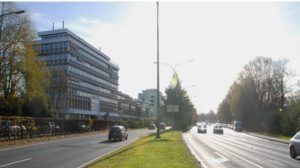
Woluwe Boulevard – before
When it was decided that a new tramline should be build on the boulevard, the designers decided to connect the project to the ongoing restoration of the Woluwe river banks. It was the perfect opportunity to transform the motorway into a parkway. This would reinforce the existing ecological and landscape continuity, manage vulnerability to flooding and transform the road from an infrastructure that was mainly oriented at cars. The end result would be a multi-use public space with a better balance between the different users – including non-human.
Main innovation and source of inspiration for this project:
- Transformation of a motorway into an parkway;
- Implementation of a tram with grassed lanes, bicycle paths and a promenade;
- Reinforcement of a metropolitan green and blue infrastructure by setting up an integrated rainwater management system, the development of an extensively managed tree and planted mall, the integration of a landscaped edge along the N2000 Parks that border the river.
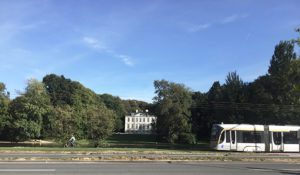
Woluwe Boulevard – after
This project is one of the first time Brussels integrated Nature-based Solutions (NBS) when redeveloping a major roadway. It especially focussed on « water management solutions », something that will become more and more important for cities as the effects of climate change become more apparent. Whilst there is still room to be more ambitious, the project has already contributed to a new culture of nature-oriented public works projects. This new way of project management is more aware of the added value of applying NBS for upscaling a project.
You can read more about this case study here, or have a look at the report of the LIFE Urban Greening Plans technical meeting.
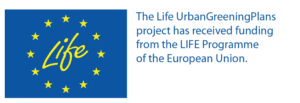
Support and Housing Possibilities for Ukrainian Colleagues
Photo by Tina Hartung on Unsplash
One month on from the beginning of the war, the difficult situation in Ukraine continues.
Protected Areas in the Carpathians are mobilising to deal with the challenges associated with more and more internally displaced people arriving in the region.
The Frankfurt Zoological Society (FZS) is providing support and relief supplies that are continuously urgently needed. With the help from Slovak, Romanian and Ukrainian partners, as well as Saxon Switzerland National Park—serving as a logistic hub for delivering necessary resources—they are making sure the goods are reaching those in need.
Romanian partners delivered over 10 tons of supplies that have been distributed to 13 Protected Areas in the Carpathians
Once again, we remind you that you can support and help refugee people in the Protected Areas of Ukraine by using the following designated donation account of the FZS:
Emergency support for Protected Areas in the Carpathians:
IBAN: DE63 5005 0201 0000 0800 02
BIC: HELADEF 1822
More information on the FZS’s initiative and support channel in English, German, Spanish, Italian, and French can be found here.
Frankfurt Zoological Society’s donation page is available here.
Housing Possibilities for Ukrainian Colleagues
You can also help by offering a place to stay for Protected Area staff members and their families fleeing Ukraine. To do so, please fill out the form with details about the type of accommodation you offer, the number of people you can accommodate and your location.
Your support is making a significant difference and is greatly appreciated!
EUROPARC will do our best, working with others like the FZS to keep communication channels open and be ready to respond and support the people and nature of Ukraine, both now and in the future.

